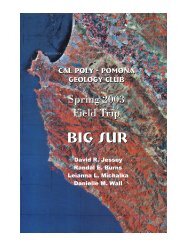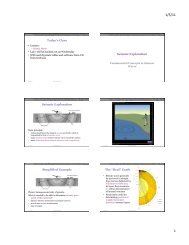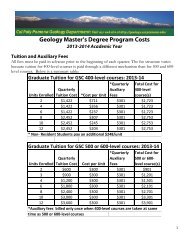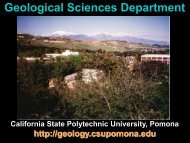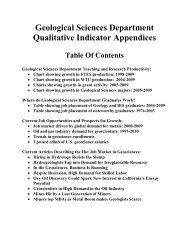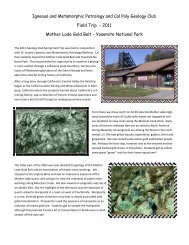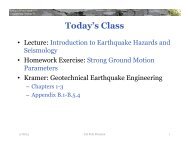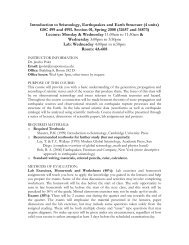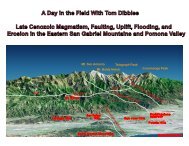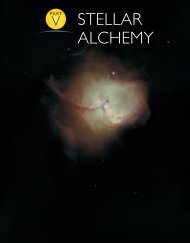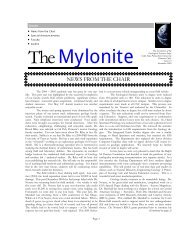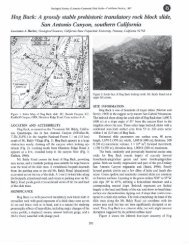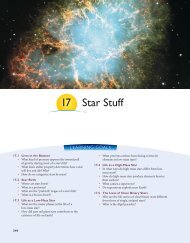Cal Poly Geology Club Death Valley Field Trip â 2004
Cal Poly Geology Club Death Valley Field Trip â 2004
Cal Poly Geology Club Death Valley Field Trip â 2004
Create successful ePaper yourself
Turn your PDF publications into a flip-book with our unique Google optimized e-Paper software.
<strong>Cal</strong> <strong>Poly</strong> <strong>Geology</strong> <strong>Club</strong><strong>Death</strong> <strong>Valley</strong> <strong>Field</strong> <strong>Trip</strong> – <strong>2004</strong>Guidebook byDon Tarman & Dave Jessey<strong>Field</strong> <strong>Trip</strong> OrganizersDanielle Wall & Leianna Michalka
DEATH VALLEYIntroductionDiscussion and <strong>Trip</strong> LogSpring <strong>2004</strong>Welcome to <strong>Death</strong> <strong>Valley</strong> and environs. During the next two days we will drive through thesouthern half of <strong>Death</strong> <strong>Valley</strong> and see some of the most spectacular geology and scenery in theUnited States. A detailed road log with mileages follows this short introductory section. Wehope to keep the pace leisurely so that everyone can see as much as possible and have anopportunity to ask questions and enjoy the natural beauty of the region.IMPORTANT: WATER- carry and drink plenty. FUEL- have full tank upon leaving StovepipeWells or Furnace Creek (total driving distance approx. 150 miles).Participants must provide for their own breakfasts Saturday morning. Lunches will be preparedat the Stovepipe Wells campground before departing. We will make a brief stop at FurnaceCreek visitor’s center and for fuel etc.Meeting PointsSaturday morning meet in front at the Chevron station on the north side of the highway a shortdistance east of the campground (8:30 AM)Sunday morning (tentative- depending upon what our last stop is Saturday) meet at the CharlesBrown highway intersection with 127 just at the south side of Shoshone. (8:30 AM). Get fuelbefore meeting.As you know we will be camping Saturday night between the hamlets of Shoshone and Tecopa.If for some reason you become separated from the main caravan during our journey Saturday –and this would be very difficult to accomplish- simply head for Shoshone/Tecopa. Once onhighway 127 continue south for about ??? miles to a point a few hundred feet north of theintersection with the paved road to left leading to Tecopa. At this point take a right turn onFurnace Creek Road (gravel) and drive west until you see our vehicles. This is where we willcamp and hold the barbeque.If you wish to visit the hot springs in Tecopa take the left turn on the surface road to Tecopa. Atthe only stop sign in town turn into the parking lot. This is Tecopa Hot Springs. No charge foruse. Mandatory nude bathing. Women’s side to the north.Introduction to the <strong>Geology</strong> of <strong>Death</strong> <strong>Valley</strong>The geology of <strong>Death</strong> <strong>Valley</strong> reflects a series of events spanning almost two billion years oftime. The most recent of these, geologically speaking, occurred very recently. Each event addedprogressively to the complexity of the previous picture. During the trip we will have anopportunity to see features which represent many of these events.2
If you've had a geology course previously you may remember that we have names used to tagintervals of geologic time. For the purposes of this course, and to avoid sounding patronizing, thestandard geologic terms will be used. Although other time terms may accidentally sneak into theconversation, the trip leaders will attempt to restrict their time designations to these terms(below). The intervals and their duration are:CENOZOICMESOZOICPALEOZOICPRECAMBRIAN65 MaBP TO NOW (MaBP = million years before present)225 MaBP TO 65 MaBP544 MaBP TO 225 MaBPPLANET FORMATION TO 544 MaBPIf it is necessary to be more specific- we are dealing with enormous intervals of time- a prefix of'early' or 'late' can be added to the interval name. For example, some of the material which makesup Tucki Mountain a few miles west from our first camp site is of early Paleozoic age.For any of those of you whose geology is a little rusty trip leaders, upon demand, will quicklyand informally review the rock types and the rock cycle. It is hoped that when you havequestions during the trip, no matter how basic, you will bring them up.Geography of <strong>Death</strong> <strong>Valley</strong>Use the maps incorporated within this guide to keep you “located” regionally. Several mainphysical features define <strong>Death</strong> <strong>Valley</strong> (see map). The west side of the south part of <strong>Death</strong> <strong>Valley</strong>is primarily formed by the Panamint Mountains with the highest point being Telescope Peak(3,368 m/11,049 ft). Tucki Mountain (pron. Tuck-eye), at the north end of the Panamints, nearStovepipe Wells, provides an informal dividing point between north and south <strong>Death</strong> <strong>Valley</strong>.Farther to the north and as rough extensions of the Panamints are the Cottonwood Mountains. Tothe southeast of the Panamints, and still on the west side of <strong>Death</strong> <strong>Valley</strong> are the OwlsheadMountains. The south end of <strong>Death</strong> <strong>Valley</strong> is created by the buttress-like Avawatz Mountains.The east side of the south end of <strong>Death</strong> <strong>Valley</strong> is formed by the Amargosa Mountains, BlackMountains and Ibex Hills. To the north of Furnace Creek the east side of the valley is formedfirst by the Funeral Mountains and then, next to the north, the Grapevine Mountains. We will beable to better understand these relationships by viewing the marvelous scale model of <strong>Death</strong><strong>Valley</strong> in the Visitor’s Center mid-day Saturday.General Geologic History of <strong>Death</strong> <strong>Valley</strong>Much of the information presented below is the result of cumulative labors of a number ofgeologists, prominent among whom are Levi Noble, Walter Bucher, Harold Drewes, BennieTroxel and Lauren Wright. Any participants in this excursion who are interested in moredetailed information about <strong>Death</strong> <strong>Valley</strong> are urged to contact the leaders who will providecitations of useful papers.We have only the dimmest of records of Precambrian in the <strong>Death</strong> <strong>Valley</strong> region. The oldestrocks we can find here are metamorphic rocks, whose original nature cannot be readilydeciphered. Some of these ancient rocks appear in the Panamint Mountains to the west. Similarrocks outcrop in the Black Mountains on the east side of <strong>Death</strong> <strong>Valley</strong> as well as in themountains to the east of Tecopa. The best estimates place the age of these old metamorphic rocksat between 1.4 and 1.8 Ga.3
The next (second) ‘event’ is really an extended series of occurrences resulting in, among otherthings, the deposition of a vast stack of sedimentary rocks, both clastic and non-clastic extendingfrom late Proterozoic until the end of the Paleozoic. It appears that all of the early events werelocated near and were partially controlled by a progressively widening rift which split aprogenitor continent called Rodinia into several components one of which North American nowresides. The lower part of this section is present only as remnant scraps here and there.Major units in this stack of stratified rocks have been assigned names based upon geographicfeatures where they were first studied in detail (see attached columnar section -Figure 1- for apartial listing of these formations). Because of metamorphism and extreme deformation/faultingmany of these rocks are unrecognizable in <strong>Death</strong> <strong>Valley</strong> itself requiring examination at a distantpoints, for example near Shoshone where they are better preserved.Although recognition of most the stratigraphic units is difficult at least one unit is unique enoughto allow relatively easy identification. At the bottom of this pile of stratified rocks is the CrystalSpring Formation. Either during or shortly after its deposition it was intruded by an enormousigneous sill tens of kilometers in length and breadth and tens of meters thick. The metamorphismassociated with this intrusion of the magma formed talc in many places. Mining of this talc hasleft white patches on hillsides where the Crystal Spring Formation outcrops. Thus anytime onesee white splashes of color in the distance you are probably looking at the Crystal SpringFormation. Similar sills in Arizona have been dated at about 1.2 Ga.The geology during Mesozoic time (third event) in the <strong>Death</strong> <strong>Valley</strong> region was controlled bythe evolution of a convergent plate boundary and a volcanic-magmatic arc to the west with theresultant intrusion/extrusion of large masses of igneous rock. The development of this arc wasmainly responsible for the termination of the carbonate (limestone) sedimentation whichdominated the geologic scene up through Paleozoic time. Large thrust faults, related to theconvergence to the west, cut the crust of the western part of North America carrying enormousthrust slices tens of kilometers to the east. These thrust faults are not well exposed in the <strong>Death</strong><strong>Valley</strong> area. Much better examples are present to the southeast in the Mesquite, Clark andMescal Mountains, to the east in the Spring Mountains as well as to the north of <strong>Death</strong> <strong>Valley</strong> inthe Last Chance Range. The amount of shortening may be somewhere in the neighborhood of 75km. One of the faults in the Clark Mountains had been precisely dated as active 145 ma.The magnificent mountains and <strong>Death</strong> <strong>Valley</strong> itself are manifestations of the operation of anenormous geothermal "engine". This engine moves a giant mosaic of slabs or plates making upthe outer one to two hundred kilometers of the earth. These slabs make up the lithosphere. Thoseof you with some geologic background may remember that the lithosphere is made up of thecrust and a small part of the upper mantle. The plates move generally away from, toward orparallel to adjacent slabs. Each sense of movement creates its own distinctive type of geologicresponse, sometimes causing large faults like the San Andreas and in other places causing theevolution of mountain ranges like the Himalayas. The rate of movement of these slabs is variablebut on the average is a few centimeters a year. The engine has been operating during all thecountless years represented in the rocks and features discussed above. Only in Cenozoic time dowe see effects in sufficient detail to begin to appreciate the magnitude of the forces which thegeothermal engine can bring to bear on the lithosphere.In the <strong>Death</strong> <strong>Valley</strong> area the plate movement during the Cenozoic (final events) causedstretching and up-arching of the crust. The uplift eventually resulted in failure of the crust alongfaults. Large segments of the crust slid slowly down these fracture surfaces leaving highstandingcliffs or scarps behind. The west face of the Black Mountains (Turtlebacks-see below)is an example of one of these scarps.Although the exact relationships are, at present, unclear, several strike-slip faults (horizontalmovement along vertical fault planes) are also involved in the formation of <strong>Death</strong> <strong>Valley</strong>. These4
strike slip faults are the <strong>Death</strong> <strong>Valley</strong> fault, the Sheephead fault and the Furnace Creek fault (alsocalled the North <strong>Death</strong> <strong>Valley</strong> Fault).At about 14 Ma movement along the Furnace Creek andSheephead faults caused the development of so-calledFurnace Creek F.Z.“rhombochasm”, a rhomb-shaped region in which thecrust is pulled apart (Figure 2). This was the progenitor ofthe current <strong>Death</strong> <strong>Valley</strong> basin. We will stop near FurnaceCreek (Zabriskie Point) where we can see rocks whichwere deposited in the depression formed when the downdroppingwas initiated. The oldest of these rocks are calledthe Artist Drive Formation well exposed along Artist’sDrive. As movement along the two faults (Furnace Creekand Sheephead faults) proceeded the fragmentation of theDOWNcrust became more severe eventually creating avenues forthe rise of magma from sources in the deep crust ormantle. These and related igneous rocks formed theShoshone volcanic field which today occupies aquadrilaterally shaped region defined by a line east-westthru of Shoshone, Furnace Creek Wash, the east edge ofmodern <strong>Death</strong> <strong>Valley</strong> and highway 127.Sheephead F.Z.In addition to the injection of magma, movement along theFigure 2two faults also provided an environment in which many ofthe older rocks were subjected to large-scale gravitationaldown-slope movement, breaking them into slivers which piled up on one another to form theAmargosa Chaos of L. Noble. We will make one stop to observe examples of these highlydeformed rocks. Noble identified three components of the “Chaos” to which he assigned thenames, <strong>Cal</strong>ico and Jubilee Phases. The Virgin Spring Phase, the oldest, is named for a location afew miles north of the highway. It is composed mainly of Proterozoic Pahrump Group, upperProterozoic and Cambrian sedimentary rocks, much attenuated in thickness. The <strong>Cal</strong>ico Phase iscomposed mainly of Tertiary volcanic rocks with the upper-most Jubilee Phase mainly ofyounger sedimentary materials. On the basis of his observations Noble believed that the phasesmoved independently of one another or at least were not emplaced synchronously with theVirgin Spring Phase more intensely faulted than the <strong>Cal</strong>ico or Jubilee Phases. The old,underlying metamorphic rocks are also involved in the faulting.Perhaps around three million years ago the movement causing the rhombochasm was transferredso that a new fault system formed which, with continued movement, eventually manifestingitself as what we call <strong>Death</strong> <strong>Valley</strong>. To understand the relationships between the normal faultsand the strike slip faults one must recognize that <strong>Death</strong> <strong>Valley</strong> is really composed of threesegments: northern, middle and southern. The northern and southern segments are both paralleland trend roughly northwest. The middle segment trends about north-south. Thus <strong>Death</strong> <strong>Valley</strong>resembles a deformed letter "Z". The active faults in the north and south segments are strike slipfaults- Furnace Creek and <strong>Death</strong> <strong>Valley</strong> fault zones- and those of the central segment are normalfaults. Additionally, the displacement along the normal faults is not purely vertical but is obliquewith the down dropped blocks moving down and northwesterly along large, curved fault surfacescalled “Turtleback” for their carapace-like shapes which we will observe at one or two of ourstops. A simple model thus emerges in which right slip along the Furnace Creek and <strong>Death</strong><strong>Valley</strong> fault zones causes an extensional zone between them where normal faults develop andcentral <strong>Death</strong> <strong>Valley</strong> is formed. The movement picture is similar to one visualized for theformation of the rhombochasm discussed above. Also see Figure 3 below.5
FurnaceCreek faultPanamintMtns.Modern<strong>Death</strong> <strong>Valley</strong>TurtlebacksBlackMountainsSouth <strong>Death</strong><strong>Valley</strong> FaultFig. 3Important Geologic Datesage of diabase sills 1.18 GA (?)Oldest rocks in <strong>Death</strong> <strong>Valley</strong> area- 1.4-1.8 GAage of faulted cinder cone 690,000 Y Age of Bonanza King F. 525 MAage of Shoreline Butte 1.5 MAPrimary opening of central <strong>Death</strong> <strong>Valley</strong> 2-3 MAInitial basins in Cenozoic formed 14 ma. (Artist Drive F. 14-7.5 MA)Last “permanent” lake in <strong>Death</strong> <strong>Valley</strong> 10,000 years Age of rocks at C. Brown roadcut 9.6 MAEarliest lake to occupy <strong>Death</strong> <strong>Valley</strong> shortly after 1.5 MAAge of igneous rocks of Owlshead Mtns. 95 MAAge of Tecopa lake beds, somewhat less than 3 MA6
Mileage<strong>Death</strong> <strong>Valley</strong> <strong>Field</strong> <strong>Trip</strong> Road Log – Day 10.0 From Stovepipe Wells Chevron head west on CA 190.0.2 (0.2) Turn left on dirt road to Mosaic Canyon.2.5 (2.3) Mosaic Canyon Parking Area (STOP 1).The entrance to Mosaic Canyon appearsdeceptively ordinary, but just a 1/4 milewalk up the canyon narrows dramaticallyto a deep slot cut into the face of TuckiMountain. Smooth, polished marble wallsenclose the trail as it follows the canyon'ssinuous curves.Mosaic Canyon's polished walls are carvedfrom the Noonday Dolomite depositedduring Late Precambrian (about 850-700million years ago). Later addition ofmagnesium altered the limestone, a rockmade of calcium carbonate, to dolomite, acalcium-magnesium carbonate. Thedolomite was later metamorphosed tomarble. Recent uplift and subsequenterosion have exposed the metamorphicrocks.Mosaic Canyon derives its name from the angular fragments of many differentparent rocks seemingly plastered to the floors and walls of the canyon just southof the parking area.Return to vehicles and CA 190.4.8 (2.3) Turn right (east) on CA 190 toward Furnace Creek.6.9 (2.1) Stop beside road to view sand dunes (STOP 2).<strong>Death</strong> <strong>Valley</strong>'s most accessiblesand dunes are just a few milesfrom Stovepipe Wells. Tucked intoMesquite Flat in the north end ofthe park, these dunes are nearlysurrounded by mountains on allsides. The primary source of thedune sands is probably theCottonwood Mountains which lie
to the north and northwest.12.3 (5.4) Turn left on North Highway.12.9 (0.6) Turn right (east) on Daylight Pass Road.19.6 (6.7) Turn right (southeast) on the Chloride Cliff/Keane Wonder/Daylight PassCutoff Road.23.8 (4.2) Turn left on the dirt road to the Keane Wonder Mine (there should be a signmarking the turnoff).26.6 (2.8) Keane Wonder Mine parking lot (STOP 3).The total gold production from the Keane Wonder Mine during its operationwas estimated at $1,100,000. Of thatamount, $625,000-$682,000 was takenfrom the mine between 1907 and1911. TheKeane Wonder mine was one of the twolargest producing gold mines in the <strong>Death</strong><strong>Valley</strong> area (Skidoo was the other).Gold production came from “quartz veins”that lie within the metamorphosed CrystalSprings Formation. Ore controls are thesubject of debate. Some have suggestedthe lithologic contact between the diabaseand carbonate; others the Keane Wonderfault; and most recently regionaldetachment surfaces similar to the Briggsgold mine in the southern PanamintMountains.Return to vehicles and paved road.29.4 (2.8) Turn left (south) on the Daylight Pass Cutoff Road.35.1 (5.7) Intersect CA 190; turn left toward Furnace Creek Ranch.44.5 (9.4) Turn right into Harmony Borax Works parking area.44.6 (0.1) Harmony Borax Works (STOP 4).W. T. Coleman's Harmony Borax Works was constructed 1882 and the town ofGreenland was built. This early outpost was later to become the modernFurnace Creek Ranch. Harmony played a central role in the opening of <strong>Death</strong><strong>Valley</strong> and the subsequent popularity of the Furnace Creek area.
Borax production began in late 1883. When in full operation, the HarmonyBorax Works employed forty men. Hardy workers scraped cottonball boraxfrom the surface of the playa, producing three tons of borax daily. "Cottonball", an ore made up of the borate minerals ulexite and proberite, was thendissolved in boiling water. As the solution cooled, borax was precipitated.Financial problems caused closure of the Harmony Borax Works in 1888.Borate mining moved to Shoshone/Tecopa for a few years then eastward to the<strong>Cal</strong>ico Mountains in the late 1890’s. Borate mining returned to <strong>Death</strong> <strong>Valley</strong> in1915 (Furnace Creek Wash) and lasted until 1928. In 1970 mining activity wasrenewed in Furnace Creek Wash and has continued intermittently to the present(Billie Mine).Return to CA 190 and turn right (south) to Furnace Creek Ranch./46.0 (1.4) Turn right into Visitor Center parking area (STOP 5).We will stop here to visit the restrooms and view the Visitor Center. It hasdisplays on the history, climate, and mining of <strong>Death</strong> <strong>Valley</strong> and a beautifulrelief sculpture of <strong>Death</strong> <strong>Valley</strong> that is well worth the stop.From the parking area turn south on CA 190.47.3 (1.3) T- intersection at Furnace Creek Inn, continue east on CA 190 toward theburgeoning metropolis of <strong>Death</strong> <strong>Valley</strong> Junction.50.9 (3.6) Turn right into the Zabriskie Point parking area (STOP 6).Our European friends have made Zabriskie Point one of the most popular stopsin the park. Their visit marks a pilgrimage to the site of an American cultclassic movie of the same name.Looking west fromZabriskie Point you can seeManley Beacon, one of thelandmarks of <strong>Death</strong> <strong>Valley</strong>.The Beacon is composed ofMiocene Artist DriveFormation (the steeply eastdippingcolorful rock unit).The Artist Drive Formationinterfingers with basalts,from whence the BlackMountains receive theirname (note the basalts capping the ridge to the southwest). These rock units areoverlain by the more drab brown, Pliocene, Furnace Creek Formation. Themost conspicuous feature of the Furnace Creek Formation is the coarseconglomerates you may have seen while driving south up the wash. TheFurnace Creek is unconformably overlain by Pleistocene gravels of the FuneralFormation. The pronounced unconformity is one of the most striking geologic
features in Furnace Creek Wash. To the east, across Furnace Creek Wash,Proterozoic - Paleozoic rocks of the Funeral Mountains are present. TheFurnace Creek fault zone marks the boundary between the markedly dissimilarlithologies of the Funeral and Black Mountains.Return to your vehicles and turn right (south) on CA 190.58.0 (7.1) Turn right on Furnace Creek Wash Road.61.5 (3.5) Stop on the right shoulder of the road (Sigma Mine) (STOP 7).The Sigma Mine marks themost recent surface miningventure in Furnace CreekWash. Little has beenpublished on the property.The deposit lies twokilometers east of Ryan andnorth of the Boraxo Mine(see write-up). It was a jointventure of Tennaco and U.S.Borax. The borate horizondips 5-15° to the northeast,has a strike length of 600meters and down dip width of 300 meters. Average thickness is 20 meters.The ore is similar to that of the Boraxo Mine, a mixture of colemanite andulexite-probertite. Host rocks appear to be limy mudstones of the FurnaceCreek Formation.Continue south on Furnace Creek Wash Road.65.5 (4.0) Fork in the road; continue on the paved road to Dante’s View.71.2 (5.7) Dante’s View parking area (STOP 8).Dante's View provides aspectacular look at <strong>Death</strong><strong>Valley</strong>'s remarkablescenery. From this vantagepoint you can viewTelescope Peak (11,049feet) to the west in thePanamint Range as well asBadwater, the lowest point(-282 ft.) in the WesternHemisphere. Thisdifference in elevation is astaggering 11,331 feet —
the greatest topographic relief in the conterminous U.S. This strikingtopography is a product of <strong>Death</strong> <strong>Valley</strong>'s very active tectonism. The entireregion has been pulled apart, fracturing the crust and creating large faults.Along these roughly north-south-trending faults mountains have uplifted andvalleys down-dropped, producing the distinctive alternating pattern of linearmountain ranges and valleys of the Basin and Range province.The floor of <strong>Death</strong> <strong>Valley</strong> tilts gently eastward. From here, one can see that thealluvial fans on the west side of the valley are far larger than on the east side.This difference results partly from the eastward tilting of the valley floor. Onthe west side, alluvial material spreads laterally and extends far onto the valleyfloor because it accumulates on a surface that is gently inclined away from therange; on the east side, the material becomes trapped near the mountain frontbecause it accumulates on a surface that is inclined gently towards themountains.This eastward tilting of the Black Mountains, the Panamint Range, and the floor<strong>Death</strong> <strong>Valley</strong> typifies much of the Basin and Range Province. Through crustalextension, the region broke into a series of tilted fault blocks. In general, theseblocks tilted away from the faults along which they rose and towards the faultsalong which they sank.Make the long trek back down (north) Furnace Creek Wash to the T-intersection across from Furnace Creek Inn.95.1 (23.9) Turn left (south) on the Badwater Road.103.7 (8.6) Turn left into the one-way Artist’s Drive (STOP 9). Time permitting me willmake the 8.8 mile drive along Artist’s Drive. There are numerous stops andoverlooks.The winding, one-way, Artist’sDrive leads you up to the scarpof the Black Mountains.Artist’s Drive rises up to thetop of an alluvial fan fed by adeep canyon cut into themountain. As you make yourway up to the mountain facethe roadway will rise and dipon the undulating surface ofthe alluvial fan. The narrowroad runs high up onto the fan,with striking views of thebarren floor of <strong>Death</strong> <strong>Valley</strong> inthe distance.The face of the Black Mountains along Artist’s Drive is made up of themulticolored rock of the Artist Drive Formation. Pink, green, purple, brown,
and black rock debris drape across the mountain front, providing some of themost scenic evidence of Miocene volcanism and lucustrine sedimentation.Weathering and alteration by thermal waters are responsible for the variety ofcolors displayed in the Artist Drive Formation. Brick-reds and pinks are due tooxidation of dispersed iron to hematite. Shades of yellow result from hydratediron oxides in variable concentration. Alkaline lakebed environmentschemically alter volcanic ash rapidly, producing an array of finely-dispersednew minerals. Among these, clinoptilolite, analcite, nontronite, and (in basalticdebris) celadonite may account for the area's pastel green tuffs and ashysediments.112.5 (8.8) Turn left (south) on the Badwater Road.116.3 (3.8) On the left is the entrance to Artist’s Drive. If you did not make the detourthrough Artist’s Drive you will need to reset your trip odometer to 0.124.2 (7.9) Badwater parking area (STOP 10).recent past.Beneath the shadows of theBlack Mountains, a great flatexpanse of shimmeringwhite spreads out beforeyou. You are at Badwater, -282 feet, the lowest point inthe Western Hemisphere.Look to the west, the whiteexpanse is made up ofalmost pure table salt theremnants of a much greener,lusher time in <strong>Death</strong> <strong>Valley</strong>’sAbout 2000-4000 years ago the climate was quite a bit wetter than today. Sowet that streams running from nearby mountains gradually filled <strong>Death</strong> <strong>Valley</strong>to a depth of almost 30 feet. Some of the minerals left behind by ancestral<strong>Death</strong> <strong>Valley</strong> lakes dissolved in the shallow water, creating a brine.The wet times didn't last. The climate warmed and rainfall deceased. The lakebegan to dry up. Minerals dissolved in the lake became increasinglyconcentrated as water evaporated. Eventually, only a briny soup remained,forming salty pools on the lowest parts of <strong>Death</strong> <strong>Valley</strong>’s floor. Salts (95%NaCl) began to crystallize, coating the surface with a thick crust about one totwo meters thick.Few people turn and face east toward the Black Mountains. If you do you willimmediately notice the Sea Level sign high up on the hillside. The steep face ofthe Black Mountains is made up of some of the oldest rocks in <strong>Death</strong> <strong>Valley</strong>.These 1.7 billion-year-old remnants of an ancient volcanic mountain belt and
flanking deposits of mud and sand have been metamorphosed to gneiss. Elevenmillion years ago, the gneiss was injected by the Willow Spring pluton. Thedioritic to gabbroic composition of the Willow Spring pluton blends well withthe dark Precambrian gneiss, so you have to look carefully to see the contactrelationship between the two rock types. Badwater is also the northernmost ofthree “turtlebacks” that lie along the Black Mountains western flank. We willbe discussing the origin of the turtlebacks at the next stop.139.2 (~15) Stop along the road for a view to the north of the Copper Canyon Turtleback(STOP 11). (Note: this is onlyan approximation of thelocation of this stop; Don willselect a location that bestshows the geologicrelationships.)Mormon Point affords anexcellent view of the profileof the Copper Canyon turtlebackand the overlyingTertiary sedimentary andvolcanic rocks that have beentransported northwestward over the turtleback surfaces. From Mormon Pointthe view to the northeast is almost at a right angle to the northwest plunge andtrend of the crest of the turtleback surface.Poorly visible from this viewpoint is the relatively thin skin of carbonate rockdirectly beneath the turtleback surface. This is because the southwest flank ofthe turtleback surface has been cut by younger faults along the mountain front.Precambrian foliated gneissic rock and foliated Mesozoic dioritic rock formmost of the range front in view beneath the turtleback. Patches of carbonaterock are exposed at the crest of ridge. A few dikes of Tertiary intrusive rockscross the turtleback at nearly right angles to the trend of the ridge crest.The turtleback surfaces were first recognized and named by Curry (1938). Sincethen they have been the subject of considerable debate. Today it is recognizedthat most of the crustal extension that has occurred in <strong>Death</strong> <strong>Valley</strong> can beattributed to low-angle normal (detachment faults). These faults juxtapose,older, strongly metamorphosed, ductility deformed mid-crustal rocks (lowerplate core complexes) and younger, largely unmetamorphosed, brittleydeformed, volcanic and sedimentary rocks (upper plate). Typically the upperplate rocks are cut by a series of high angle normal faults. The Black Mountainfault zone is an example of a major detachment fault. <strong>Death</strong> <strong>Valley</strong> hasdropped downward and tilted to the east along the detachment surface. Thefault zone remains active today as evidenced by numerous high angle faultscarps that can be seen dissecting the alluvial fans.
152.8(13.6) Road forks, stay on the paved road CA 178 (Jubilee Pass Road)160.0 (7.2) Park on road shoulder; Amargosa Chaos (STOP 12).Noble (1941) observeda style of faulting in thissubject area so intricateand complex that hereferred to the faultedrock units as “chaos.”He referred to these, aswell as other similarlyfaulted terranes in the<strong>Death</strong> <strong>Valley</strong> region, asthe “Amargosa chaos.”The Virgin Spring areain the west-central partof the Black Mountains is the type locality for the Amargosa chaos.The geologic features of the Amargosa Chaos record four major deformationalevents. The first, about 1.7 Ga, accompanied and followed the metamorphismof the crystalline basement. It contributed to the angular discordance in thecomplex with the overlying later Precambrian sedimentary units. The secondbegan with the deposition of arkosic conglomerate near the base of the CrystalSpring Formation and continued through Noonday time, spanning an interval ofprobably 400 Ma. This event was accompanied by vertical crustal movementcausing facies changes in the Pahrump Group and Noonday Dolomite, and theangular unconformity beneath. Folds preserved in the later Precambrian andCambrian sedimentary rocks mark a third period of deformation in Mesozoic orEarly Tertiary time. The fourth deformational event can be related to faultingcaused by crustal extension in late Cenozoic time.Noble (1941) recognized three phases of the Amargosa chaos and named themthe Virgin Spring, <strong>Cal</strong>ico, and Jubilee phases. The Virgin Spring phase iscomposed almost entirely of units of the Pahrump Group and of the overlyinglatest Precambrian and Cambrian units. The <strong>Cal</strong>ico phase consists mostly ofTertiary volcanic units. The Jubilee phase comprises Tertiary conglomerate,finer-grained strata, and bodies of mono!ithologic breccia.The best exposure of the Virgin Spring chaos along <strong>Cal</strong>ifornia 178 occurs atthis stop. The chaos underlies the steep north face of a hill about 300 ft high anddisplays most of the features that are commonly ascribed to the lower part ofthe chaos in general.The lower part of this face is underlain by the gray weathering, locally redstainedcrystalline complex. Within it are sheared masses of dark green diabasedikes and nearly white granitic pegmatite dikes. All are thoroughly sheared andbecome progressively more so upward to the nearly horizontal contact with theoverlying chaos. The strong evidence of shearing along this contact impressed
Noble to the extent that he identified it as his Amargosa thrust (nowdiscredited).The pale gray to dark lavender, fault-bounded lenses at the base of theoverlying chaos consist of arkosic sandstone and siltstone of the dominantlyclastic lower portion of the Crystal Spring. The dark green lenses higher on theface are slices of the diabase sill that separates the clastic members from thered-brown carbonate member. The ridge-former at the crest of the hill is theyellowish gray dolomite of the Noonday Dolomite. Strata of the JohnnieFormation are exposed on the south side of the hill crest. Both the Noonday andJohnnie occur as fault-bounded lenses and thus also qualify as chaotic.177.5(17.7) Intersection with CA 127, turn right (south) to Shoshone.179.0 (1.5) Downtown Shoshone, END of Day 1.Mileage<strong>Death</strong> <strong>Valley</strong> <strong>Field</strong> <strong>Trip</strong> Road Log – Day 20.0 Day 2 begins at the junction of the Charlie Brown Highway (CA 178) and CA127 just south of Shoshone. Head west on CA 178.3.9 (3.9) Charlie Brown Highway road cut (STOP 1).This is one of the more famousroadcuts in <strong>Cal</strong>ifornia geology. Itexposes not only a spectacularexample of the interior of a weldedtuff, with a layer of remelted obsidian,but also a normal fault that has beenphotographed for many basic geologytexts. The fault cuts Miocene tuff andvolcaniclastic deposits. The darkbrown layer in the footwall rocks is aconglomerate. A prominent blackband just to the left of this photo is awelded tuff comprised of volcanicglass and flattened pumice fragments.Return to vehicles, turn around and head back west to CA 127.7.8 (3.9) Turn left (south) on CA 127.13.0 (5.2) Turn left on the Tecopa Hot Springs Road.
17.4 (4.4) Turn left (east) on the Spanish Trails Highway.18.9 (1.5) Turn right on Furnace Creek Road.27.1 (8.2) Turn left on the dirt road just past the cattle guard.28.3 (1.2) Follow the main dirt road to the War EagleMine (STOP 2).The War Eagle Mine is located 8 miles eastof Tecopa, <strong>Cal</strong>ifornia at the south end ofthe Nopah Range. It operated from 1912until 1957; the last operator the AnacondaCopper Corporation. Despite the extensivemine workings and obviously large tonnageof ore removed from this mine and theadjacent Columbia and Noonday Minesastonishingly little has been published.However, extensive archival information onthe mine is stored at the University ofWyoming and may be examined for a fee.The mine workings are entirely withinNoonday Dolomite. Mineralization appearsto lie along a nearly north-trending veinwhich dips moderately to the east. Examination of the adjacent mines suggeststhe main ore vein is offset by a post mineral fault system which strikes N 65°W. A series of northeast trending fractures with steep northwest dips areresponsible for localization of the ore.Mine workings extend approximately 500 feet below the existing adit. Accessis via a series of raises and an inclined shaft. The main ore zone has beendeveloped for several thousand feet along strike.Ore mineralization is restricted to argentiferous galena, but traces ofchalcopyrite and pyrite were noted in stopes. Native gold occurs in traceamounts. Reportedly, the upper extension of the ore shoot has been oxidized tocerrusite and anglesite.The main adit to the War Eagle remains open despite vandalism that occurred anumber of years ago. Vandals rolled an ore car down the main inclined shaftpartially blocking access to the lower mine working and prompting the BLM tothreaten closure of the entrance portal. Sealing of the mine never occurred andthe vandals were never caught.Return to Furnace Creek Road.
29.5 (1.2) Turn right (west) on Furnace Creek Road.31.1 (0.6) Turn left on Western Talc Mine Road.34.3 (3.0) Park near the open pit of the Western Talc Mine (STOP 3).Talc was first produced from <strong>Death</strong> <strong>Valley</strong> in 1910. Pressure from the ParkService in the form of an asbestosscare closed all mines within thepark in 1980. Production outsideof the park continued until thelate 1990’s. In their heyday the<strong>Death</strong> <strong>Valley</strong> talc mines yielded20% of the annual talc tonnage.All talc deposits lie within theCrystal Springs Formation andoutcrop along a 50 mile belt fromthe Panamint Mountains to theKingston Range. Specifically, thetalc ore bodies are the products ofcontact metamorphism ofcarbonate layers during intrusion of Proterozoic diabase sills.The Western mine has the most extensive workings and the longest operatinghistory of the talc mines in the southern <strong>Death</strong> <strong>Valley</strong>-Kingston Range region.The property consists of seven patented and four unpatented claims, formerlyowned and operated by the Western Talc Company.Here, as at numerous other localities in the surrounding region, the talc-bearingzone has formed as an alteration of cherty dolomite at the base of the CrystalSpring Formation. A diabase sill forms the footwall of the talc bodies throughmost of the mine area, but in the southern part, elongate bodies of greenalteration rock separate the talc from diabase.Most of the claims are distributed along two north-striking segments of thesame alteration zone that are displaced along a northeast-striking fault. The twosegments have a combined strike length of several thousand feet and appear tobe the largest intact bodies of commercial talc in the <strong>Death</strong> <strong>Valley</strong> region.In mine exposures, the zone of talcose alteration is 30 to 100 feet thick andconsists chiefly of saleable material. The zone contains two principal types ofcommercial talc: (1) laminated tremolite rock (generally referred to as “hardtalc”) which occurs as a 10-20 foot thick layer in the lower part of the zone, and(2) talc schist (generally referred to as “soft talc”) most of which is confined tothe upper part of the zone. A thick layer of brown alteration rock ordinarilyforms the upper part of the zone, separating talc schist from unaltered chertydolomite. The brown rock is in sharp contact with the talc schist, but has agradational contact with the overlying cherty dolomite.
Turn around and proceed back to Furnace Creek Road.37.3 (3.0) Turn left on Furnace Creek road toward Tecopa.44.9 (7.6) Turn left (west) on Spanish Trails Highway50.3 (5.4) Turn left (south) on CA 127 toward Baker.68.6 (18.3) Pull into Harry Wade Historical Maker turnoff (STOP 4).END OF FIELD TRIP
Keane Wonder MineWestern mining brings to mind the old prospector and hisburro wandering the desert in search of the "mother lode".<strong>Death</strong> <strong>Valley</strong> is the image of desert most often conjured up.Not surprisingly, the "mother lode" was never found in <strong>Death</strong><strong>Valley</strong>, but more astonishing is the fact that very little gold hasbeen found in the <strong>Death</strong> <strong>Valley</strong> area. Although there are 50precious metal mines and prospects scattered throughout themonument, none ever reported substantial production and onlythe Skidoo District in the Panamint Range has shown anysignificant potential. Total gold production from all mines in<strong>Death</strong> <strong>Valley</strong> was probably less than 200,000 ounces (aboutthe annual production of many gold mines in northernNevada).The Keane Wonder mine is of interest because it is typical of <strong>Death</strong> <strong>Valley</strong> preciousmetal mines, and the dumps and mill site have been preserved as a historic landmarkmaking the area accessible. Also typical of most gold-silver mines in the Park, littledefinitive information has been published on the geology. This is not unexpected sincethe heyday of mining activity was near the turn of the century and a trip to <strong>Death</strong> <strong>Valley</strong>was not a coveted assignment for government and academic geologists of that era.HistoryTwo residents of Ballarat--an Irishman named Jack Keane and his partner, a one-eyedbutcher named Domingo Etcharren, were prospecting for silver in the winter of 1903.They had been working on a particular claim for several months, but had discoverednothing of value. In fact, both men were local legends for their ineptitude having foundnothing after eight years of prospecting. While returning to Ballarat for supplies, Keaneaccidentally stumbled across an outcrop of visible gold. The locals felt it was a “wonder”Keane had found anything at all. Hence, the mine became known as the Keane WonderMine.The news of their strike started a gold rush. Keane and Etcharren filed 18 claims andwere immediately besieged with offers to buy the mine. Captain J.R. Delmar agreed topay the partners $10,000 in cash. In return he received an option to purchase the mine for$150,000 once the property had been developed. He brought 30 men to the property,built an sssay office, a general office building, and a wagon road to within a mile of themine. Alas, he spent all of his money and had none left to purchase the mine, so thepartners took it back.In 1906, John Campbell purchased the property for $250,000. A company was set upwith Jack Keane as president, Campbell as vice president and Domingo Etcharren as thesecretary. Stock was offered to the public and new claims patented despite the fact thatonly five of the original claims had been explored at this point. Campbell’s fortune was
wiped out by the 1906 San Francisco earthquake and within a month the mine was soldyet again. Homer Wilson bought the mine in June of 1906 and began an association withthe Keane Wonder that would last ten years. Keane and Etcharren sold their interest inthe mine making Wilson the sole owner. Wilson built a 20 stamp mill at the foot of theFuneral Range and the engineering marvel of its day, a 4700 foot aerial tramway. Loadedore buckets from the mine came down the mountain under gravity and pulled emptybuckets back up. The final costs for the mill were estimated at $85,000. A boardinghouse was built to house the workers and by Oct. 27, 1907 the mill, with completed tram,began to operate. Twenty-one thousand board feet of lumber were required for the uppertramway terminal, 28,000 for the lower, and 25,000 for the intermediate towers. Therewere 13 towers in the tram and the longest span between them was 1200 feet. Thevertical fall from top to bottom was 1500 feet.By 1909, 50 men were working at the mill and mine and work had begun on a cyanidemill. In 1911, the Keane Wonder Mine was the only mine still producing in the region.Although it had been plagued by financial problems since the Wall Street Panic of 1907,it continued to operate. In August, 1912 the mine closed for two years. In 1914, itreopened for two years after being sold to new owners. Twenty years later another revivaloccurred when a new company reworked the old mill tailings by cyanide leaching. In1937 the mine was sold and the mill dismantled and removed. The tramway wasrefurbished in 1942 but the mine never reopened. In the 1970s it was purchased by theNational Park Service.The total production of the mine during its operation was estimated at $1,100,000. Of thatamount, $625,000-$682,000 was mined between 1907-1911. The Keane Wonder minewas one of the two largest producing gold mines in the <strong>Death</strong> <strong>Valley</strong> area (Skidoo wasthe other). The scope of the operation, the duration of production and the story of twoincredibly lucky miners add up to a mine that ultimately surpassed even the grandeur ofthe name "Keane Wonder Mine."General <strong>Geology</strong>The Chloride Cliff Mining District (sometimes termed the Bullfrog South) lies on thewest flank of the Funeral Mountains, approximately 30 kilometers east of Stove PipeWells. The Funeral Mountains consist of strongly metamorphosed Late Proterozoic andPaleozoic sedimentary rocks overlain by weakly metamorphosed late Proterozoic,Paleozoic and Tertiary rocks. The contact between the two sedimentary packages ismarked by a series of low angle range-front (detachment?) faults.No outcrops of basement rock have been mapped in the central or western FuneralMountains, however some have suggested that the gneisses which floor Monarch canyonmay be basement rock. The oldest identified rocks consist of interbedded schist, marble,quartzite and amphibolite, which represent high-grade metamorphic equivalents of thePahrump Group (Figure). The Pahrump Group is in turn overlain by the JohnnieFormation, which consists predominantly of schist and quartzite. The Stirling Quartzitecomprised of quartzite and minor marble overlies the Johnnie Formation. Argillites and
quartzites of the Wood Canyon Formation overlie the Johnnie. Smaller outcroppings ofCambrian rocks occur locally. The Paleozoic section is capped by middle and lateTertiary volcanics and lucustrine sediments.The structure of the Funeral Mountains is dominated by a doubly plunging anticlineconsisting of a core of high grade metamorphic rocks overlain by low grademetasedimentary rocks. The contact between the two rock assemblages is marked by theBoundary canyon fault system, a gently undulating surface that dips to the north.<strong>Geology</strong> of the Keane Wonder Mine AreaThe Chloride Cliff Mining District is a geologically complex area and as such it isdifficult to do justice to the geology. This discussion will be largely a generalization forthe sake of simplicity.The prominent Chloride Cliffs are comprised of Beck Spring Dolomite, underlain by theCrystal Spring Formation. Much of the rugged slope from the Chloride Cliffs to thevalley floor is Crystal Springs, however, complex faulting also results in small isolatedoutcrops of Kingston Peak, Johnnie and Stirling Formations. The following descriptionis given to allow some differentiation::<strong>Geology</strong> of the central Funeral Mountains
• Stirling Quartzite - Pale gray, medium-to-coarse-grained sandstone(orthoquartzite), locally conglomeritic.• Johnnie Formation - Greenish-gray, pelitic schists.• Kingston Peak Formation - Upper member is a conglomerate with clasts ofquartzite and marble in a dark fine-grained groundmass. Lower member is peliticschist, generally silverish in color with a bright luster.• Beck Spring Dolomite - Pale white, gray or cream marble.• Crystal Spring Formation - Upper member is a pelitic schist and micaeousquartzite with lesser marble and amphibolite,; Middle member is mostly palemarble and interlayered schist; Lower member is pelitic schist with abundantamphibolite (diabase), layers and minor carbonate.In the vicinity of the Keane Wonder mine the dominant rocks are middle and lowerCrystal Spring Formation with marble, pelitic schist and amphibolite, common. Most ofthe central portion of the southern flank of the Funeral Mountains is bounded by theKeane Wonder fault. The fault, which is poorly exposed, dips 20° to the southwest.Proterozoic and Paleozoic rocks lie above the fault, while folded and stronglymetamorphosed Proterozoic strata lie beneath the fault plane.The gold ore occurs in two discontinuous, lenticular quartz veins which appear to followbedding planes, particularly the contact between marble and amphibolite; the latter themetamorphic equivalent of diabase. The quartz veins can be traced for 500 meters alongtheir N 25° W strike. The veins dip 20° E and vary in thickness from 2 to 8 meters. Oreminerals include free gold, minor pyrite and galena. Iron-staining is common, anindication of near surface oxidation of pyrite to hydrated iron oxides.Ore grades are reported to have been about .25 oz/ton and total production from the 1908-1916 period about 35,000 ounces of gold. The development consisted of a 75 meter deepshaft and over 2000 meters of underground workings, most of which are nowinaccessible. There has been no activity on the property since it was abandoned in 1916,but rumored sampling by the Park Service in the 1980s indicates there is significantrecoverable gold remaining in the mine dumps.
Harmony Borax Works – Twenty Mule TeamsThe first form of borax to be found in <strong>Death</strong> <strong>Valley</strong> was white crystalline ulexite called“cottonball”, which encrusted the ancient Lake Manly. Cottonball of this kind had beenfound earlier at Columbus Marsh and at Teel’s Marsh, in western Nevada.The first man to try to market <strong>Death</strong> <strong>Valley</strong> cottonball was an unsuccessful goldprospector named Daunet. In 1875 he could interest no one in his discovery. Fate madehim six years too early.In 1881 Aaron Winters, who lived in Ash Meadows with his wife, Rosie, offered anight’s lodging to a stranger, Henry Spiller, who was prospecting through the desert. Hishospitality was well rewarded. The stranger spoke of the growing interest in the mineralborax and showed him samples of cottonball. One look told Winters that he saw the samecrystals every day, covering acre upon acre of the floor of <strong>Death</strong> <strong>Valley</strong>.The next morning, as soon as his visitor left, Winters rode off to the <strong>Valley</strong>, scooped up abagful of cottonball and rode back to Ash Meadows. The stranger had told him about thetest for borax: pour alcohol and sulfuric acid over the ore and ignite it. If it burns green,it’s borax. At sundown, Aaron and Rosie tried the test on the bagful of sample: “Sheburns green, Rosie”, shouted Aaron, “We’re rich, by God!” And they were. Winters soldhis <strong>Death</strong> <strong>Valley</strong> claims to William Tell Coleman, a prominent San Francisco financierfor $20,000.Word of the <strong>Valley</strong>’s cottonball quickly spread. Daunet came back in 1882 and set up theEagle Borax Works, but quit the business when he found that borax could not beprocessed by simple recrystallization during the intense summer heat. By the timeoperations could resume in the fall, the price of borax had fallen and he was never able tomake the operation profitable.In 1882 Coleman began construction of theHarmony Borax Works. In 1883 he hiredChinese laborers to scrape borates from theancient lake bed for $1.50 per day. In fulloperation, the Harmony Borax Worksemployed forty men. "Cotton ball", an oremade up of the borate minerals ulexite andproberite, was then dissolved in boilingwater. As the solution cooled, borax wasprecipitated. The hardy workers (notice noChinese labors in the photo to the right)produced three tons of borax daily. Findingthat summer processing in the <strong>Valley</strong> was indeed impossible, he built the AmargosaBorax Works near Shoshone, where the summers were cooler. The ruined remains ofthese three early borax plants still stand in the desert. The borax was hauled to the nearestrailroad by the use of Twenty Mule Teams hitched to ponderous wagons. Coleman was
producing about 2 million pounds of borax per year from his <strong>Death</strong> <strong>Valley</strong> and Amargosafacilities.In 1882 the Lee brothers discovered a new form of borax along Furnace Creek Wash.This new mineral was named colemanite after Coleman. A quartz-like ore, it demandedfar more complex mining methods than cottonball, but it was far richer in borax.Coleman added these borax deposits to his holdings but he never developed them. Hisfinancial troubles in 1888 closed the Harmony Borax Works, and they never reopened.In 1890 Coleman sold his properties to an energetic and successful borax prospector fromTeel’s Marsh named Francis Marion “Borax” Smith for $550,000 giving Smith a virtualmonopoly on domestic borax production. Smith consolidated these properties with hisown to create the Pacific Coast Borax Company.The Twenty Mule TeamsThe twenty mule teams solved atransportation problem: between 1883and 1888 they hauled more than twelvemillion pounds of borax from remoteand inaccessible <strong>Death</strong> <strong>Valley</strong> to therailroad at Mojave.When the Harmony Borax Works wasbuilt in 1882, teams of eight and tenmules hauled the ore. But with increasedproduction, the first teams of twentymules were tried. Stretching out morethan a hundred feet from the wagons, thegreat elongated teams immediately proved a dependable means of transportation.The borax wagons were large and well built. The rear wheels were 7 feet high, the frontwheels 5 feet high. Each wheel had a steel tire 8 inches wide and an inch thick. The hubswere 18 inches in diameter and 22 inches long. The spokes were of split oak, the axletreeswere solid steel bars. The wagon beds were 16 feet long and 6 feet deep, and couldcarry 10 tons of borax. Fully loaded, the wagons, including the water tank, weighed 36.5tons.The distance to Mojave was 165 miles. Traveling fifteen to eighteen miles a day, it tookten days to make the trip. After leaving the <strong>Valley</strong> the teams had to cross 100 miles ofempty desert, where many of the overnight stops were at dry camps. Water tanks weretherefore attached to the wagons, to supply the men and animals between springs.Three men operated these twenty mules teams – in actuality eighteen mules and twohorses – the driver who wielded a formidable whip; the teamster, who harnessed andunharnessed the mules, rode one of the horses, and handled the brake of the lead wagon;and the swamper, who rode on the rear wagon, operated its brake on the downgrades, and
was chief cook and dishwasher.When borax was discovered in the <strong>Cal</strong>ico Mountains early in the 1890’s, twenty muleteams hauled the ore from Borate to the railroad at Daggett. Except for the brief interludewhen the traction engine “Old Dinah” attempted the job, borax was carried solely bythese teams until the Borate & Daggett Railroad was built around 1895.History of Borate MiningOn October 12, 1872 Francis “Borax” Smith discovered borax at Teel’s Marsh, Nevadaand until 1881 the marsh was the center of the United States borax industry. In 1881,Aaron and Rose Winters identified ulexite in the playa at the mouth of Furnace CreekWash in <strong>Death</strong> <strong>Valley</strong>. The Winters sent samples of their discovery to W.T Coleman andCo. who purchased the property and in 1882, built the famous Harmony Borax Worksnear the discovery site and began processing the ulexite or “cottonball” as it was called.That same year a new borate mineral, later named colemanite, was discovered further tothe south along Furnace Creek Wash.The process Coleman employed to produce borax from “cottonball” was simple. Hedissolved the material in boiling water, allowed the solution to cool and the borax toprecipitate. The only problem lie in the fact that summers in <strong>Death</strong> <strong>Valley</strong> were too hot toallow the solution to cool sufficiently for the precipitation of borax. Fortunately, anotherborate discovery was made near Tecopa. Here summer temperatures reached a maximumof only 11 0 0 F and borax could be produced all year round. In winter, the richer depositsin Furnace Creek Wash were processed and in summer operations were moved toTecopa.Coleman and Co. was thus owner of two borax deposits, but they were an arduous 250kilometer trek from the nearest railhead in Mojave. Coleman decided the only solutionfor economical shipment of the borax to railhead was a fleet of large wagons pulled bymule teams, the 20-mule teams that were to become a <strong>Death</strong> <strong>Valley</strong> legend. From 1883 to1888 the teams made the 20 day round trip without a single breakdown.In 1883, colemanite was discovered near the present site of Barstow and Coleman beganpurchasing claims in the area. Unlike ulexite, colemanite was not readily soluble and themines were costly underground operations. Coleman went bankrupt in 1888 and sold hisclaims to “Borax” Smith who consolidated his Nevada holdings with those he acquired in<strong>Cal</strong>ifornia into the Pacific Coast Borax Company, later to become U.S. Borax.Smith closed the Harmony and Tecopa operations and began mining at Borate north ofBar-stow. With depletion of the Borate deposits in sight Smith purchased the Lila Cproperty in 1902. To reduce costs Pacific Coast Borax constructed the Tonopah andTidewater Railroad from Ludlow to <strong>Death</strong> <strong>Valley</strong> Junction and in 1907 began shippingore from the Lila C mine. Borate operations were suspended. The Lila C produced until1914 when operations were moved to the upper Furnace Creek Wash near the town siteof Ryan. Deposits in Furnace Creek Wash produced from 1915 until 1928 when thefamous Boron deposit was discovered in Kern County. Since Boron was a sodium borate,
processing costs were lower and shipping costs to the port of Los Angeles were alsolower since the shipping distance was reduced.Borate mining ceased in the <strong>Death</strong> <strong>Valley</strong> area until 1970 when Tenneco Oil beganproduction of colemanite from the Boraxo mine, later to be joined in 1976 by AmericanBorate from the Billie mine. Passage of Public Mining Law in 1976 placed severerestrictions on mining in National Parks and Monuments, essentially eliminating surfacemining. The result was the closure of all surface mines in Furnace Creek Wash. However,the Billie mine, an underground operation, remains in intermittent production.General <strong>Geology</strong>Borate deposits of <strong>Death</strong> <strong>Valley</strong> (Figure) are of two types: (1) accumulations of ulexiteand associated minor borate minerals in Holocene playa lake beds that occupy the floorof <strong>Death</strong> <strong>Valley</strong> and (2) colemanite, ulexite, probertite and associated minor borateminerals in bedded lake sediments in the Pliocene Furnace Creek Formation in theFurnace Creek Wash area. All of the more recent mining has been from Furnace CreekWash.The Furnace Creek Formation lies between the Oligocene (?) to Pliocene Artist DriveFormation and the Plio-Pleistocene Funeral Formation. These units have been folded intoa broad syncline cut by steeplydipping faults with smalldisplacements. On the east, theseformations are separated from thePaleozoic rocks of the FuneralMountains by the northwest-trendingFurnace Creek fault and on the westthey are separated from the volcanicsand sediments of the BlackMountains by a frontal fault system.The Furnace Creek Formation iscomprised of 2500 meters ofinterlayered lucustrine sediments,pyroclastics, and basaltic volcanics.Deposits of colemanite and ulexite/-probertite are found several meters tohundreds of meters above the base ofthe formation. The main boratedeposits are interstratified with mudstone,shale, limestone andconglomerate. Most major depositsare truncated by steeply dippingfaults.The borate mines and properties of the <strong>Death</strong><strong>Valley</strong> region.
It is generally thought that borates were formed from hot springs emanations into shallowplaya lakes. Boron is discharged into the calcium-sodium enriched waters where it accumulatesuntil evaporation causes the precipitation of sodium and calcium borates.Probertite is formed by burial dehydration of ulexite. Some colemanite also appears tohave been deposited by secondary remobilization. of original borates due to ground watercirculation. Evidence for this comes from secondary veinlets of colemanite which crosscut the existing mineralized zones and the deposition of colemanite along fault planes.Boraxo MineThe Boraxo mine lies 3 kilometers southwest of the mining camp of Ryan at an elevationof 800 meters. The property was originally claimed by Pacific Coast Borax in 1915. KernCounty Land Company acquired the property in 1960 and when the company wasmerged with Tenneco Inc. in 1967 the property was turned over to the Tenneco Oil andMinerals subsidiary for development. Initial pit excavation began in 1974, production in1975 and abandonment in 1977.The Artist Drive and Furnace Creek Formations in the mine area have been folded into ananticline the axis of which plunges to the east (Figure). Several steeply dipping faultswith small displacements cut the section. The Furnace Creek Formation is comprised of400 meters of interlayered tuffaceous mudstone and sandstone with abundant limeylaminations. The rocks are yellow to green on weathered surfaces. Minor basalt occurslocally 150-300 meters above the base of the formation.The ore body is lenticular and is situated on the south limb of the anticline within a fewmeters to tens of meters above the base of the Furnace Creek Formation. It is cut on thenorth by the Pit fault and pinches out on the south 300 meters below the present surface.The deposit ranges m thickness from a feather-edge to about 40 meters, averaging 15meters. Maximum east-west strike length is 1000 meters and width 200 meters. The orebody dips approximately 40~ to the south. After minimal processing at the mine site orewas either trucked to Lathrop Wells, Nevada for calcining if it was primarily colemanite,or shipped to Dunn Siding west of Baker for grinding if it was ulexite-probertite.
Talc DepositsTalc production was first reported from <strong>Death</strong> <strong>Valley</strong> in 1910, although the presence oflarge talc bodies had been noted as early as the late 1800’s. From 1910 until 1978, <strong>Death</strong><strong>Valley</strong> was a significant producer, accounting for 10-20% of the annual U.S. total.Pressure from the Park Service closed the last mines in 1980, although substantial talcreserves remain. Talc mining outside the National Park has continued to the present day,although only one mine remains in operation.Talc deposits occur in the Crystal Springs Formation of Late Proterozoic (Precambrian)age at the south end of <strong>Death</strong> <strong>Valley</strong> (Fig. 1). The belt of deposits, encompassing 50mines and prospects stretches eastward to the Kingston Range. The most productive areaswere within the National Park in the adjacent Warm Spring and Galena canyons.Figure 1. Index mapMineralogy and Uses of TalcTalc is a hydrous magnesium silicate (Mg 3 (Si 4 O 12 )(OH),) containing 63.5% SiO 2 , 31.7%MgO and about 5% water. In nature, talc rarely occurs in pure form but rather isintergrown with other silicates such as tremolite chlorite, epidote and diopside. Thisresults in commercial talc of widely varying composition. In general the compositionalrange does not deter from the marketability of the talc.
Commercial talc falls into four categories:• Steatite: Compact, massive and fine-grained: can be sawed, drilled ormachined to required shapes. Usually it is heat treated to convert thetalc to clinoenstatite which is used as insulation.• Soft platy talc: An alteration product of dolomite with chlorite as acommon accessory. This is the most important type of talc and is usedin wide variety of ceramic, paper, roofing and plastic products.• Tremolite talc: Massive or laminated rock with varying percentages oftremolite, anthophyllite, calcite and dolomite. It is characterized by ahigh CaO content, and is often in demand for products which require agreater cohesive strength.• Mixed talc: Various types of talc; usually any type which is notcharacterized as one of the above. Used for applications that are lessselective in terms of oxide mineral content.Most commercial talc products are a blend of two or more types specifically designed tomeet the specifications of the buyer. For example, the ceramic industry prefers hardmassive, white talc while the paint and plastics industries prefer soft, foliated tak. <strong>Death</strong><strong>Valley</strong> talc, because of its purity commanded a premium price and was much in demandfor specialized applications requiring higher purity, such as cosmetics.General <strong>Geology</strong>Talc in southern <strong>Death</strong> <strong>Valley</strong>-Tecopa area occurs only in the Crystal Spring Formation,the stratigraphically lowest member of the Pahrump group of Late Proterozoic age. TheCrystal Spring Formation is 1000 to 1400 meters thick and consists characteristically of:(1) lower unit-interbedded quartzite and shale (50-400 meters thick; (2) middle unitmassivedolomite and limestone with minor chert (10-200 meters thick); (3) upper unitintercalatedshale, quartzite and carbonate (100-400 meters thick) and (4) intrusive sillsof diabase (100-500 meters thick). The most persistent of the diabase sills liesimmediately below the middle carbonate unit of the Crystal Spring.Contact metamorphism of the carbonate unit during intrusion of the diabase sills hasproduced the talc mineralization as well as widespread silicification of the Crystal SpringFormation. Typically, zones of silicification range from a few centimeters to 100 metersin thickness. The persistent diabase sill at the base of the middle carbonate unitmentioned above, has produced the best talcose alteration and most of the mines haveexploited this zone.<strong>Geology</strong> of the Southern Nopah Range and Alexander HillsThe Alexander Hills, which form a southerly extension of the Nopah Range consistmostly of later Precambrian and Cambrian formations (Fig. 2). These have been archedinto a very broad, east-plunging anticline, about three miles wide and bordered on the
north and south by major, east-trending faults. The more northerly of the faults occupiesthe gap that separates the Alexander Hills from the Nopah Range proper.The Crystal Spring Formation, containing all of the typical members, is exposed for adistance of about 2 3/4 miles along the lower part of the west face of the hills. Theformation contains a talc-bearing zone which has formed along the upper margin of adiabase sill and is an alteration of cherty dolomite at the base of the carbonate member.At the southern end of the Alexander Hills, the Crystal Spring Formation is successivelyover-lain by the Beck Spring Dolomite and Kingston peak Formation to form one of thefew essentially complete occurrences of the Pahrump Group west of the Kingston Range.From this locality, for a distance of about seven miles northward, successively lowerunits in the Pahrump Group are progressively cut out along the contact with the overlyingNoonday Dolomite, so that in the southem end of the Nopah Range, strata of the CrystalSpring Formation wedge out northward, and the Noonday Dolomite rests directly uponearlier Precambrian metamorphic rocks. Most of the talc that has been mined in the areaof the Alexander Hills and southern Nopah Range has been obtained from two northtrendingsegments of the talc-bearing zone, each on the west side of the hills. The moresoutheasterly segment about 1 ½ miles long, contains most of the workings of theWestern mine and the Acme mine. For a distance of about half a mile between the twomines the zone lies unexposed and unexplored beneath Tertiary fanglomerate. The othersegment of the zone, which appears to be at least 2700 feet long, contains the remainingworkings of the Western mine. Movement along a northeast-trending fault has separatedthe two an apparent horizontal distance of about 4000 feet so that the southern segmenthas moved northeastward with respect to the other.Another talc deposit is contained in highly faulted rocks at the southeastern tip of theAlexander Hills and is the site of the Booth mine. This deposit occurs along a nearlyhorizontal fault-contact between earlier Precambrian metamorphic rocks and dolomite ofthe Crystal Spring Formation, In a similar geologic setting is the talc deposit at the DonnaLoy mine, which is near the tip of the wedge of Crystal Spring strata in the southern partof the Nopah Range.Figure 2. View looking northeastward of Alexander Hills, showing theWestern mine area.
Figure 3. <strong>Geology</strong> of a portion of the Western Talc Mine
The Western MineThe Western mine has the most extensive workings and the longest operating history ofthe talc mines in the southern <strong>Death</strong> <strong>Valley</strong>-Kingston Range region. The propertyconsists of seven patented and four unpatented claims, formerly owned and operated bythe Western Talc Company.The talc bodies at this locality were being worked as early as 1912 and may have beenopened one or two years before then. The claims of the Western mine cover all of thetalc-bearing exposures in the northwest quarter of the Alexander Hills and in the low areato the northwest of the hills. Here, as at numerous other localities in the surroundingregion the talc-bearing zone has formed as an alteration of cherty dolomite at the base ofthe Crystal Spring Formation. A diabase sill forms the footwall of the talc bodies throughmost of the mine area, but in the southern part, elongate bodies of green alteration rocklocally separate the white rock from the diabase.Figure 4. Cross section through a portion of the Western Talc Body.
War Eagle MineThe War Eagle Mine is located 12 kilometers east of Tecopa, <strong>Cal</strong>ifornia at the south end of theNopah Range. It operated from 1912 until 1961, the last operator the Anaconda Copper Corporation.Despite the extensive mine workings and obviously large tonnage of ore removed fromthis mine and the adjacent Columbia and Noonday Mines astonishingly little has been published.Much of this can be attributed to the untimely death of the Chief Mine Geologist in 1957.The mine workings are entirely within Noonday Dolomite, although the contact with underlyingbasement rocks is reportedly exposed to the north in the Gunsight mine. Mineralization appearsto lie along a nearly north-trending vein which dips moderately to the east. A brief examinationof the mine suggests the main ore vein is offset by a post mineral fault system which strikes N65° W. A series of northeast trending fractures with steepnorthwest dips are thought to control localization of theore bodies.Although little information is available on the mineworkings, levels are thought to have been developed to atleast 175 meters below the existing entrance adit. Accessto lower levels is via a series of raises and an inclinedshaft. The main ore zone has been developed for severalthousand feet along strike.Ore mineralization is restricted to argentiferous galena,but traces of chalcopyrite, sphalerite and pyrite werenoted in stopes. Native gold has been reported, but recentassay work in the late 1970’s suggests gold ore grades aresubeconomic. Reportedly, the upper extension of the oreshoot has been oxidized to cerrusite and anglesite.Typical gangue alteration minerals such as siderite,jarosite and iron and manganese oxides are commonthroughout the mine workings. Figure 5 is a geologic mapof the southern portion (about 1/4) of the War Eagle mineworkings. Note that the main ore body, near the top of themap follows a vein system that strikes appoximately N50E. Mineralization has been stoped both above andbelow the level of this map.Figure 5. Geologic map of thesouthern War Eagle mine.
<strong>Geology</strong> and Historyof the Resting Springs Mining DistrictLocation and HistorySuzanne BaltzerThe Resting Springs Mining District is located at the southern end of the NopahRange one and a half miles from the Resting Springs Arabian horse ranch and sevenmiles south of Tecopa. This district encompasses several mines. The main ore producerswere the Gunsite, Noonday, Columbia, Grant and War Eagle mines. The ore produced bythese mines was chiefly lead and silver. The Gunsite workings, located north of the WarEagle, are the oldest. The Gunsite was located and developed in the spring of 1875 bytwo brothers, William D. and Robert D. Brown. The Browns were also responsible forthe discovery of the Darwin silver district located in the Inyo Mountains. The twobrothers laid out the Willow Springs town site located six miles southeast of RestingSprings in anticipation of what they hoped would be a new “boom” camp. In Septemberof 1876 the town was renamed Tecopa (after a local Paiute leader) by the new owner ofthe mines and township Jonas D. Osborne, a former mining superintendent from Eureka,Nevada. Osborne located several investors in Los Angeles and they incorporated the LosAngeles Mining and Smelting Company.In the beginning the operations looked promising. The wood used in developmentof the mines was brought in from a sawmill in the Spring Mountains 35 miles away.Initially, the ore was easily processed and during its first night of operation the smelterturned out 67 bars of bullion. The ore was richer in silver than galena (a lead sulfide),however processing it turned out to be more difficult and expensive as most of it was inthe form of lead carbonates, instead of the softer, easier to process galena. During thenext several years the mines were worked intermittently depending on funding and newrefining processes but finally in May 1881 the Los Angeles Mining and SmeltingCompany closed its operations.In 1906 the Tonopah and Tidewater Railroad was built within a few miles ofResting Springs, assisting mining operations by lowering transport costs. During theperiod 1912 to 1928 nearly $3,000,000 of lead-silver ore was produced, primarily by theTecopa Consolidated Mining Company. In 1947 the Anaconda Copper Companypurchased the mines and called them the Shoshone Mines. The principle mines withinthis group were the Noonday (2/3 mile northwest of the War Eagle), the Columbia (1/4mile southwest of the Noonday) and the War Eagle. The Gunsite deposit was not workedby the Anaconda Company. During the period 1947 to 1956 almost $4,000,000 of silverleadore was produced by the Shoshone Mines. The richest ores of the group wereproduced from the War Eagle workings. Ore production of the Shoshone Mines Groupdiscontinued in 1957.
<strong>Geology</strong>The mine workings lie entirely within the Proterozoic Noonday Dolomite., amassive, highly weathered, cream-colored dolomite. Rusty weathering sand grains,especially in the upper part, locally makes cross bedding evident. Fracturing andbrecciation is common, forming fissures for ore deposition. The mines lie above theunconformable contact between a granite gneiss and the Noonday formation. TheProterozoic Johnnie formation lies in conformable contact above the Noonday. Thiscontact is well exposed near the Gunsite mine, northwest of the War Eagle mine. The orelies within a series of steeply dipping (sometimes vertical) north-south trending faults.The ore consists chiefly of lead carbonates with some unoxidized galena. Argentiferousgalena was the primary ore mineral, but oxidation has produced cerrusite and anglesite.In 1951 the War Eagle was the most important producing mine of the Shoshone Minesgroup. Lateral workings of the War Eagle are quite extensive. This field trip stop isactually the “back” side of the workings. These workings continue through to the otherside of the hill we are facing, however this connection has recently collapsed and you areno longer able to walk through the mine workings to the “front” side of the War Eagle.The road to the “front” side of the mine is nearly undriveable, thereby making the “back”side of the mine much more accessible.SummaryThe history of the Resting Springs Mines was sporadic and not as “colorful” asother mining districts in the area. However, in terms of lead and silver production it wasconsidered one of the three largest lead producers within the state of <strong>Cal</strong>ifornia. Betweenthe discovery of the district in 1876 to its final days of operations in 1957 the RestingSprings Mining District was responsible for production of more than $7,000,000 worth oflead-silver ores. Today, all that is left are mine workings and memories to be explored byrockhounds, mineral collectors and history aficionados.
From Mason <strong>Geology</strong> of the Tecopa Area, Southeastern <strong>Cal</strong>ifornia GSA BulletinVol 59 #4, pp.332-352 Plate 2



